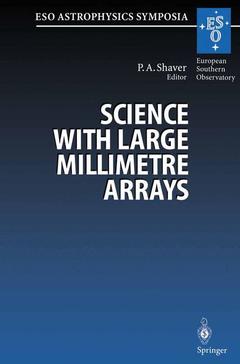Description
Science with Large Millimetre Arrays, Softcover reprint of the original 1st ed. 1996
Proceedings of the ESO-IRAM-NFRA-Onsala Workshop, Held at Garching, Germany 11–13 December 1995
ESO Astrophysics Symposia Series
Coordinator: Shaver Peter
Language: English
Subject for Science with Large Millimetre Arrays:
Keywords
Accretion; Redshift; astronomy; cosmology; galaxies; gravitation; instruments; planet; quasar; quasars; radio astronomy; solar system; star; star formation; stellar evolution
Publication date: 04-2014
409 p. · 15.5x23.5 cm · Paperback
409 p. · 15.5x23.5 cm · Paperback
Description
/li>Contents
/li>
The next major step in millimetre astronomy, and one of the highest-priority items in radio astronomy today, is a large millimetre array with a collecting area 2 of up to 10 000 m . A project of this scale will almost certainly require inter national collaboration, at least within Europe, and possibly with other major partners elsewhere. In order to establish a focal point for this project within Europe, a study has been undertaken by the Institut de Radio Astronomie Mil Ii met rique (IRAM), the European Southern Observatory (ESO), The Onsala Space Observatory (OSO), and The Netherlands Foundation for Research in Astronomy (NFRA). In the context of this project, a workshop attended by some 100 participants was held at ESO Garching on December 11-13, 1995 to discuss the scientific advances such an array will make possible. Throughout the three days of the workshop the strong enthusiasm for the concept of a large millimetre array in the southern hemisphere (the Large South ern Array, or LSA) was obvious, and it became clear that such a facility would have a profound impact on almost all areas of observational astrophysics. It was particularly clear that, since their main science drivers (cosmology, and the origins of galaxies, stars and planets) are the same, and their angular resolutions and sensitivities similar, the LSA and the VLT would strongly complement each other.
1. Introduction.- Millimetre Astronomy in the 21st Century.- A 10000m2 Southern MM Array.- 2. Science with Large Millimetre Arrays.- The Nature and Observability of Protogalaxies.- Observability of Early Evolutionary Phases of Galaxies at mm Wavelengths.- Studying High Redshift Starburst Galaxies with a Large (Sub)millimetre Array.- Deep Surveys with a Large Submillimetre Array.- The LSA and Galaxy Surveys.- The LSA and Gravitational Lensing.- Primordial Molecules.- 1.3 mm Detection and Mapping of Radioquiet QSOs at Very High z.- Molecular Lines in Absorption (and Emission) from Distant Galaxies and Quasars.- Millimeter-VLBI with a Large Millimeter Array: Future Possibilities.- The Variable Microwave Continuum of Radio-Loud AGN.- Millimeter Radiation from Normal Galaxies and AGN.- Submillimetre Observations of Low Ionization BAL Quasars.- Dynamical Studies of Spiral Galaxies.- Kinematics and Distribution of Molecular Gas in Galaxy Nuclei.- Star Formation and Molecular-Gas Dynamics in Galaxies with the Nobeyama Array and LSA.- Radio Recombination Lines from External Galaxies.- Molecular Gas in Early-Type Galaxies.- Magellanic Cloud Studies with Large mm Arrays.- Will the LSA Detect Continuum or Line Emission from AGB Stars in the LMC?.- High-Resolution Submm and MIR Imaging of the Central Parsec of the Milky Way.- New Evidence for Interaction of a Molecular Cloud/HII Region with the G359.54+0.18 Nonthermal Filaments.- Galactic Molecular Clouds.- Millimeter-Wave Absorption Spectroscopy of Molecular Clouds.- Astrochemistry.- Abundance and Origin of Galactic Water.- Interferometric Observations of Sagittarius B2: Evidence for Grain Chemistry.- A Hot Ring in the Sgr B2 Molecular Cloud.- High-Density Filaments in the Photodissociation Region (PDR) Associated with NGC 7023.- Searching for Star Formation Regions.- Infrared and mm Data for Class I Candidates.- Observations of Young Stellar Objects with Large Millimeter-Wave Arrays.- Protoplanetary Disks.- Observations of Bipolar Molecular Outflows with Large Millimeter Arrays.- Accretion and Outflow in a Protostellar System in Corona Australis.- Masers at Millimeter and Submillimeter Wavelengths.- Millimeter Recombination Lines from Dense Envelopes Around Young Stars.- Millimeter Continuum Observations of Stars.- AGB Star Envelopes as Probes of Stellar Evolution and Time-Dependent Chemistry.- CO Observations of Short Period Miras.- Planetary Nebulae.- Supernovae with the Large Southern Array.- Study of Planetary Atmospheres.- Asteriods and Comets: The Prospect for Observations with a Large Millimetre Array.- An Extension of the European Millimetre VLBI Network: Plans for a mm Radiotelescope in Greece.- Science with Large Millimetre Telescopes.- 3. A Large Millimetre Array in the Southern Hemisphere.- The Synergy Between a Large Southern Array and the Very Large Telescope of ESO.- A European Study Project for a Southern Millimetre Array.- Large Southern Array: Feasibility.- On the Imaging Efficiency, Speed, and Sensitivity of Millimetre Arrays.- Site Survey for a Large Southern Array.- Correction of Atmospheric Phase Fluctuations.- Atmospheric Phase Correction Based on Sky Emission in the 210–248 GHz Band.- Phase Correction Strategies for the Australia Telescope Compact Array at Short Wavelengths.- Innovative Telescope Designs.- Millimetre Receiver Technology for a Large Array.- Correlator Developments for (Sub)millimeter Telescopes.- 4. Workshop Summary.- Concluding Remarks.
© 2024 LAVOISIER S.A.S.




